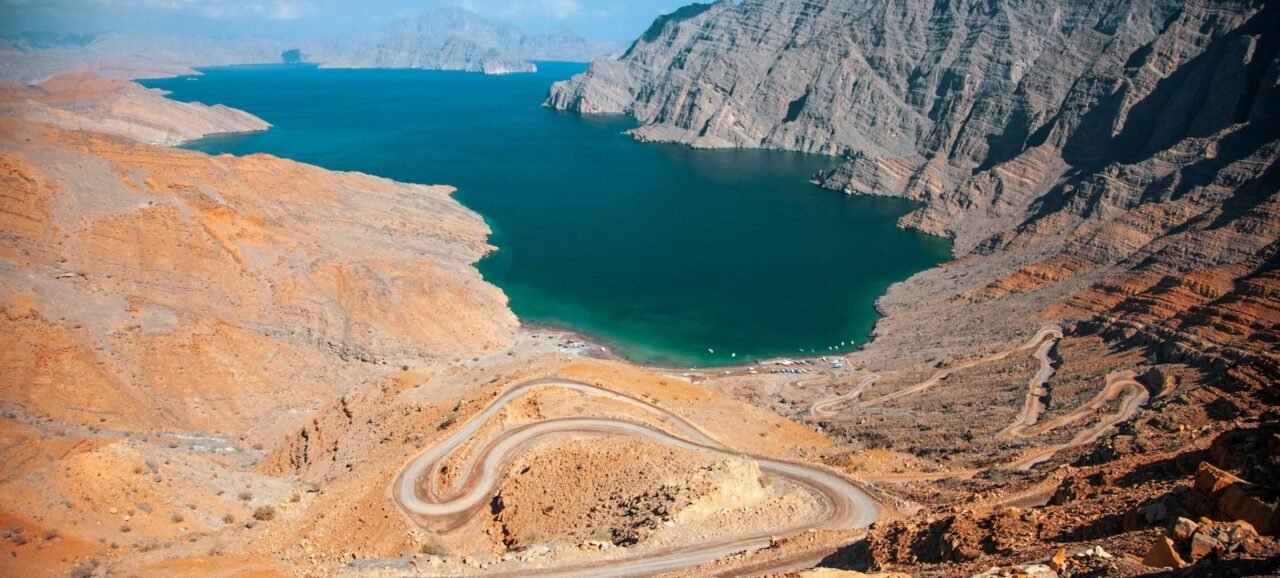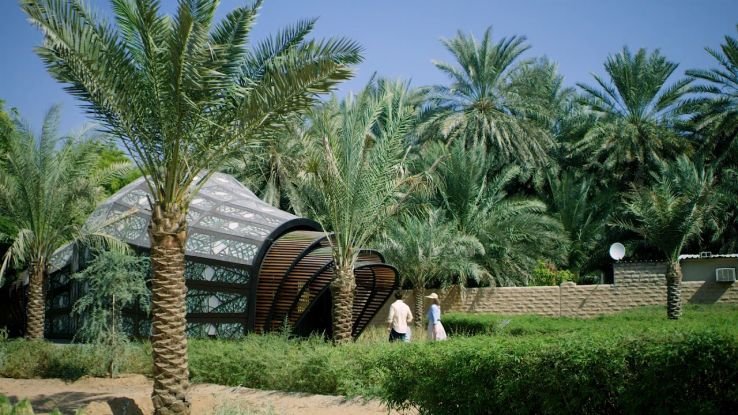
Top 30 Tourist Attractions in Oman - You Shouldn't Miss
- Travel
- 29 June 2024
- 13 Mins
- Last Updated: 31 October 2024
Oman, the land of breathtaking deserts, picturesque mountains and historic cities, is a true gem on the Arabian Peninsula. With its rich history, diverse culture and breathtaking landscapes, Oman offers a variety of attractions to captivate every traveler. In this article, we will explore the top attractions in Oman that you definitely shouldn’t miss.

Top Tourist Attractions in Oman
- Muscat – The vibrant capital
- Sultan Qaboos Mosque
- The Al-Alam Palace
- The Royal Opera House
- Nizwa – The Historic City
- Nizwa Fortress
- The Nizwa souk
- Jebel Shams – The Grand Canyon of Oman
- Wahiba Sands – The Endless Desert
- Sur – The coastal town
- The Maritime Museum of Sur
- The dhow shipyards of Sur
- Wadi Shab – A natural paradise
- The Bahla Fort
- Al-Hoota Cave
- Salalah – The Green City
- The ancient city of Sumhuram
- The Al-Baleed Archaeological Site
- The beaches of Mughsail
- The Land of Frankincense
- Incense Museum in Salalah
- The incense route
- The turtle beaches of Ras al Jinz
- The oasis city of Al Ain
- The Al Ain National Museum
- Al-Hamra – The Living Open Air Museum
- Bait Al Safah
- The village of Misfat al Abriyeen
- Jebel Akhdar – The Green Mountain
- The Palace of Bayt al Rudaydah

1. Muscat – The vibrant capital
Muscat, the capital of Oman, is a fascinating mix of traditional Arab culture and modern development. The city offers a variety of attractions including the Sultan Qaboos Mosque, Al-Alam Palace and the Royal Opera House. The Muttrah Corniche, with its lively souks and picturesque harbor, is another highlight not to be missed.
Tips:
- Best time to visit is from October to April.
- Dress modestly, especially when visiting religious sites.

2. Sultan Qaboos Mosque
The Sultan Qaboos Mosque is one of the largest and most magnificent mosques in the world. With its impressive architecture, artistic mosaics and huge chandelier, it is a masterpiece of Islamic architecture. Visitors are welcome to explore the mosque and admire its beauty.
Tips:
- Open to non-Muslim visitors from 8 AM to 11 AM, Saturday to Thursday.
- Dress modestly, with women required to cover their hair.

3. The Al-Alam Palace
Al-Alam Palace is the official residence of the Sultan of Oman and a symbol of power and splendor. The palace is surrounded by beautiful gardens and is an impressive sight, especially at sunset.
Tips:
- The palace grounds are not open to the public, but you can take photos from the gates.

4. The Royal Opera House
The Royal Opera House in Muscat is a cultural center that regularly hosts international opera and ballet performances, concerts and other cultural events. It is an impressive building that harmoniously combines tradition and modernity.
Tips:
- Check the schedule and book tickets in advance for performances.
- Guided tours are available on non-performance days.

5. Nizwa – The Historic City
Nizwa, once the capital of Oman, is known for its historic fortress and traditional souk. The Nizwa Fortress, with its thick walls and soaring towers, offers a glimpse into the country’s rich history. The Nizwa souk is famous for its silverware, pottery and traditional daggers (Khanjar).
Tips:
- Visit on Fridays to experience the traditional goat market.
6. Nizwa Fortress
The Nizwa Fortress is one of the oldest and most impressive fortresses in Oman. It was built in the 17th century and offers breathtaking views of the city and the surrounding mountains. Visitors can explore the various rooms and exhibitions and learn more about the history and culture of the region.
Tips:
- Open daily, with guided tours available for a deeper understanding of its history.
7. The Nizwa souk
The Nizwa Souk is a lively market where you can buy a variety of traditional products. From handmade jewelry and pottery to fresh spices and local delicacies, the souk offers an authentic shopping experience.
Tips:
- Great place to buy souvenirs; haggling is common.

8. Jebel Shams – The Grand Canyon of Oman
Jebel Shams, the highest mountain in Oman, is often referred to as the Grand Canyon of Oman. With its breathtaking gorges, sheer cliffs and spectacular views, Jebel Shams is a paradise for hikers and nature lovers. The hike to the summit offers unforgettable views and a feeling of grandeur.
Tips:
- Best visited from October to April.
- Wear sturdy hiking boots and bring plenty of water.

9. Wahiba Sands – The Endless Desert
The Wahiba Sands are an endless desert landscape that stretches for hundreds of kilometers. With its high sand dunes, spectacular sunsets and traditional Bedouin camps, the Wahiba Desert is a place of peace and seclusion. A desert safari or an overnight stay in a Bedouin camp are experiences not to be missed.
Tips:
- Consider booking a guided tour for a safe and informative experience.
- Camel rides and dune bashing are popular activities.

10. Sur – The coastal town
Sur, a charming coastal town in eastern Oman, is known for its traditional boat building and picturesque coastline. The city is an important historic port and offers a variety of attractions including the Maritime Museum and the famous Dhow shipyards.
Tips:
- Visit the lighthouse at Ras al Hadd for stunning views.
11. The Maritime Museum of Sur
The Maritime Museum of Sur tells the story of Oman’s maritime traditions and boatbuilding craft. Visitors can marvel at ancient navigation instruments, traditional dhows and historical artifacts.
Tips:
- Open daily, with exhibits in both Arabic and English.
12. The dhow shipyards of Sur
Sur’s dhow shipyards are a fascinating place where traditional wooden boats are still made by hand. A visit to the shipyards offers an insight into the centuries-old craft of dhow building and Oman’s maritime history.

13. Wadi Shab – A natural paradise
Wadi Shab is a picturesque valley known for its turquoise pools, impressive waterfalls and lush palm groves. A hike through Wadi Shab leads to a hidden pool and waterfall located in a cave – a perfect place to swim and relax.
Tips:
- Bring water shoes and swimwear; the hike to the waterfall can be challenging.

14. The Bahla Fort
Bahla Fortress, a UNESCO World Heritage Site, is one of the oldest and most impressive fortresses in Oman. The massive clay fortress with its high walls and towers offers a fascinating insight into the country’s history and architecture.
Tips:
- Visit the nearby pottery shops for traditional Bahla pottery.
15. Al-Hoota Cave
Al Hoota Cave is one of the largest and most spectacular caves in Oman. With its impressive stalactites and stalagmites, underground lakes and mysterious passages, the cave is a popular destination for adventurers and nature lovers.
Tips:
- Guided tours available; wear comfortable shoes as the cave can be slippery.

16. Salalah – The Green City
Salalah, located in southern Oman, is known for its lush green landscapes, white sandy beaches and ancient ruins. The city offers a variety of attractions including the ancient city of Sumhuram, the Al Baleed Archaeological Site and the stunning beaches of Mughsail.
Tips:
- Best time to visit is during the Khareef season (June to September).
17. The ancient city of Sumhuram
The ancient city of Sumhuram, also known as Khor Rori, is a significant archaeological site and a UNESCO World Heritage Site. The city’s ruins offer a fascinating insight into the history of the incense trade and the ancient civilization of southern Oman.
Tips:
- Visit the adjacent museum to learn more about the history of the site.
18. The Al-Baleed Archaeological Site
Al-Baleed Archaeological Site is another significant historical landmark in Salalah. The ruins of an ancient city and the remains of an old port tell the history of the region and its importance in the incense trade.
Tips:
- Open daily; guided tours are available for a more in-depth experience.

19. The beaches of Mughsail
The beaches of Mughsail, with their white sand and crystal clear waters, are a beach lover’s paradise. The spectacular blowholes that spray water into the air and the picturesque cliffs make Mughsail beaches one of the most beautiful coastal spots in Oman.
Tips:
- Visit during low tide to see the blowholes in action.
20. The Land of Frankincense
Oman is famous for its high-quality incense, which has played an important role in the country’s culture and economy for thousands of years. A visit to the incense museums and exploring the incense routes offer a deep insight into the meaning and history of this valuable resin.
Tips:
- Visit the Frankincense Museum to learn more about its history.
21. Incense Museum in Salalah
The Frankincense Museum in Salalah is a fascinating museum that showcases the history and importance of frankincense in Oman and the world. Visitors can discover ancient incense burners, historical documents and modern production methods.
Tips:
- Allocate at least an hour to explore the exhibits.
- It’s a great spot to buy authentic Omani frankincense as a souvenir.
22. The incense route
The Frankincense Route, an ancient trade route that runs through Oman, connects the production sites of frankincense with the ports and trading centers of the ancient world. A journey along the Frankincense Route offers a unique insight into the history of trade and the cultural significance of incense.
Tips:
- Guided tours are available to explore sections of this historic route.
- Wear comfortable shoes and bring a hat and sunscreen.
23. The turtle beaches of Ras al Jinz
Ras al Jinz is a nature reserve on the coast of Oman known for its turtle beaches. Every year thousands of sea turtles come here to lay their eggs. A visit to Ras al Jinz offers a unique opportunity to observe these majestic creatures in their natural environment.
Tips:
- Book a guided tour for the best experience.
- Visits are usually scheduled for the evening or early morning to coincide with turtle activity.

24. The oasis city of Al Ain
Al Ain, a picturesque oasis town on the border with the United States.
Arab Emirates, is known for its green gardens, historic buildings and traditional markets. The city offers a variety of attractions including Al Ain Oasis, Al Ain National Museum and Al Ain Zoo.
Tips:
- Best visited during the cooler months.
- Explore the Al Ain Oasis, Al Jahili Fort, and the Al Ain National Museum.
25. The Al Ain National Museum
The Al Ain National Museum is a fascinating museum that showcases the history and culture of the region. With a variety of exhibitions including archaeological finds, traditional crafts and historical documents, the museum provides a comprehensive overview of the rich history of Al Ain and Oman.
Tips:
- Open daily, with English and Arabic descriptions for exhibits.
- Allocate at least an hour to explore.
26. Al-Hamra – The Living Open Air Museum
Al-Hamra, an ancient mud-brick city in the heart of Oman, is a living open-air museum. The well-preserved mud houses, narrow streets and traditional buildings offer a fascinating insight into life and architecture of bygone times. Visiting Al-Hamra is like traveling back in time.
Tips:
- Explore on foot to fully appreciate the architecture and atmosphere.
- Visit Bait Al Safah for a deeper understanding of Omani traditions.

27. Bait Al Safah
Bait Al Safah is a traditional house museum in Al-Hamra that offers visitors a glimpse into the life and culture of the Omani people. The museum showcases traditional crafts, cooking techniques and household items depicting daily life in Al-Hamra centuries ago.
Tips:
- Check for demonstrations of traditional crafts like weaving and pottery.
- Enjoy traditional Omani coffee and dates.
28. The village of Misfat al Abriyeen
Misfat al Abriyeen, a picturesque mountain village near Al-Hamra, is known for its terraced gardens, ancient stone houses and impressive views. The village offers a variety of hiking trails and paths that lead through the beautiful countryside and offer unforgettable views.
Tips:
- Wear comfortable walking shoes and be prepared for some uphill walking.
- Bring a camera to capture the stunning views.
29. Jebel Akhdar – The Green Mountain
Jebel Akhdar, also known as the Green Mountain, is a fertile mountain range in the heart of Oman. With its terraced orchards, fragrant rose fields and picturesque villages, Jebel Akhdar is a paradise for nature lovers and hikers. The cool temperatures and lush vegetation make it a popular travel destination during the hot summer months.
Tips:
- Best visited in the spring when the roses are in bloom.
- Hire a 4×4 vehicle as the terrain can be challenging.
30. The Palace of Bayt al Rudaydah
The Palace of Bayt al Rudaydah, located at the foot of Jebel Akhdar, is a stunning example of traditional Omani architecture. The palace offers a glimpse into the life of the Omani aristocracy and the history of the region.
Oman is a country full of wonders and surprises. From the vibrant streets of Muscat to the historic forts of Nizwa, the endless expanses of the Wahiba Sands and the verdant mountains of Jebel Akhdar, Oman has something to offer every traveler.
The top attractions in Oman offer a rich mix of history, culture and nature that will delight every visitor. Immerse yourself in the beauty and diversity of this fascinating country and let yourself be enchanted by its treasures.
FAQs
The best places to visit in Oman include Sultan Qaboos Mosque, Nizwa Fortress, Jebel Shams, Wahiba Sands and Mughsail beaches.
The best way to explore the Wahiba Sands is with a desert safari or an overnight stay in a Bedouin camp to experience the spectacular sand dunes and sunsets.
Jebel Shams is the highest mountain in Oman and offers breathtaking views of deep gorges and sheer cliffs, often referred to as the Grand Canyon of Oman.
Nizwa is home to the impressive Nizwa Fortress and the traditional souk known for its silverware and pottery.
In Sur, you can visit the dhow shipyards, admire traditional wooden boats and explore the Maritime Museum, which showcases the region’s maritime history.
Wadi Shab offers turquoise pools, impressive waterfalls and lush palm groves, ideal for hiking, swimming and relaxing.




